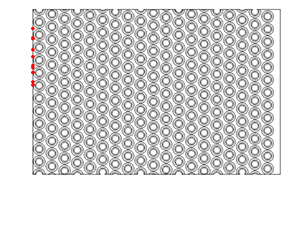Microfluidic devices are important for many applications including lab-on-a-chip devices, as well as the characterization and manipulation of nanoscale particles. The goal of our current research related to nanomanufacturing of microfluidic devices is to improve methods of fabricating, testing, and manufacturing microfluidic devices capable of “liquid phase” atomic layer deposition on nanoparticles. In pursuit of this research goal, we are exploring methods of high-throughput nanoparticle manipulation in microfluidic channels, including advanced fabrication methods for these devices.
Bottom-Up Nanofabrication-Inspired Geometries for Deterministic Lateral Displacement (DLD)
DLD is a method of size-based sorting of particles in microfluidic channels that uses as an array of micro/nanoposts to guide particles along different flow streams based on their diameter (Figure 1). While researchers have explored many different post shapes to optimize DLD-based particle manipulation, to date there have been no studies of alternative post array geometries that could improve particle separation or offer specific device fabrication advantages. In this work we demonstrate for the first time that array patterns fabricated by “bottom-up” nanofabrication methods, including nanosphere lithography, can be used for deterministic particle separation based on size (Figure 2).
Quantification of Defects in Nanosphere Lithography
Nanosphere lithography (NSL) is a bottom-up, self-assembly approach that enables rapid, low-cost patterning of nanoscale features. The practical application and scalability of NSL relies on the ability to achieve defect-free nanosphere self-assembly over large substrate areas. Self-assembly methods for single-layer nanosphere templates are typically evaluated using scanning electron microscopy (SEM) imaging, with literature reports focusing on maximum area of continuous nanosphere coverage. An alternative metric—namely, the percentage of nanospheres exhibiting perfect hexagonal close-packing (%HCP)—is uniquely critical to NSL precision and repeatability.
To enhance current methods of evaluating nanosphere self-assembly, we have developed an SEM image analysis approach for rapidly quantifying packing defects in single-layer nanospheres to determine %HCP (Figure 3). The method uses variations in SEM edge effect brightness to distinguish spheres with perfect packing from those in defect configurations or along edges. Comparison of image analysis program results with manual counting of nanospheres indicates that the program has a high degree of accuracy, with a mean error on the %HCP metric of +8.6% (absolute error).
3D Printed DLD Microfluidics
In collaboration with the Bioinspired Advanced Manufacturing (BAM) Laboratory at the University of Maryland (PI Ryan Sochol), we have developed advanced methods for 3D printing of stacked, microfluidic devices for DLD-based particle manipulation. These works have been highlighted on the front cover of Lab on a Chip and in American Scientist.
Highlights:
- First theoretical model and experimental demonstration of deterministic lateral displacement devices with “bottom-up” inspired array geometry based on nanosphere lithography (NSL).
- Development of the first-reported methodology for quantifying percentage hexagonal close-packing in NSL masks.
- Design of experiments linear regression modeling of nanosphere self-assembly via spin-coating for single-layer NSL applications.
- In collaboration with BAM Laboratory (U of Maryland): first demonstration of sub-micron particle manipulation using additively-manufactured DLD arrays.
Publications :
- Talha Razaulla, Olivia M. Young, Abdullah Alsharhan, Ryan D. Sochol, and Roseanne Warren, “Deterministic lateral displacement using hexagonally arranged, bottom-up-inspired micropost arrays,” Analytical Chemistry, Vol. 94, 1949-1957, 2022. link
- Talha Razaulla, Michael Bekeris, Haidong Feng, Michael Beeman, Ugochukwu Nze, and Roseanne Warren, “Multiple Linear Regression Modeling of Nanosphere Self-Assembly via Spin Coating,” Langmuir, Vol. 47, no. 42, pp.12419-12428, 2021. link
- Michael Bekeris, Takara Truong, Stephen Carron, Zahra Karimi, Haidong Feng, Ugochukwu Nze, Michael Beeman, Ryan D. Sochol, and Roseanne Warren, “Rapid Quantification of Nanosphere Lithography Packing Defects Using Scanning Electron Microscopy Edge Effects,” physica status solidi Rapid Research Letters, Vol. 14, pp. 20032, 2020. link
- Abdullah T. Alsharhan, Anthony J. Stair, Ruben Acevedo, Talha Razaulla, Roseanne Warren, and Ryan D. Sochol, “Direct Laser Writing for Deterministic Lateral Displacement of Submicron Particles,” Journal of Microelectrochemical Systems, 29, pp. 906-911, 2020. link
- Abdullah T. Alsharhan, Ruben Acevedo, Roseanne Warren, and Ryan D. Sochol, “3D microfluidics via cyclic olefin polymer-based in-situ direct laser writing,” Lab on a Chip, Vol. 19, pp. 2799-2810, 2019. DOI: 10.1039/C9LC00542K (Featured on the front cover of Lab on a Chip and in American Scientist, November-December 2019). link
Presentations:
- Adira Colton, Olivia Young, Talha Razaulla, Roseanne Warren, and Ryan D. Sochol, “Toward Deterministic Lateral Displacement-Based Continuous-Flow Microfluidic Particle Reactors via Direct Laser Writing,” Proceedings of the 20th Solid-State Sensors, Actuators and Microsystems Workshop (Hilton Head 2022), Hilton Head Island, SC, USA.
- Talha Razaulla, Olivia Young, Abdullah T. Alshahran, Ryan D. Sochol, and Roseanne Warren, “Deterministic Lateral Displacement via Self-Assembly-Based Hexagonally Arranged Triangular Posts,” Proceedings of the 25th International Conference on Miniaturized Systems for Chemistry and Life Sciences (μTAS 2021), Palm Springs, October 2021 (Poster Presentation).
Funding: This research was sponsored by NSF Award #1761273: Collaborative Research Liquid Phase Atomic Layer Deposition of Thin Films on Nanoparticles Using Three-Dimensionally Printed Microfluidics
[su_row] [su_column size=”1/3″] [su_youtube url=”https://youtu.be/XBaXOOono5o”][/su_column]
[su_column size=”1/3″] [/su_column]
[/su_column]
[su_column size=”1/3″] [/su_column]
[/su_column]
[/su_row]
Figure 1. Left: Video of a microfluidic device showing laminar flow in a DLD channel using clear and black-dyed water streams. Center, Right: COMSOL Multiphysics simulations of size-based particle separation in a DLD nanopost array. Particles with diameter less than the array’s “critical diameter” pass straight through (red), while larger particles travel in “bump mode” at an angle through the array.
Figure 3: Image analysis program for quantification of packing defects in single-layer nanosphere hexagonally-close packed (HCP) arrays. (Left) 3D CASINO simulation of the “SEM edge effect” in nanospheres. As the secondary electron interaction volume approaches the edge of a non-HCP nanosphere, secondary electrons will diffuse out of the sphere resulting in a brighter region around the outline of the sphere. This effect is suppressed in perfectly HCP nanospheres (center), enabling identification and quantification of non-HCP spheres (right) based on variations in SEM image brightness. (pss-RRL, 14, 20032, 2020).


